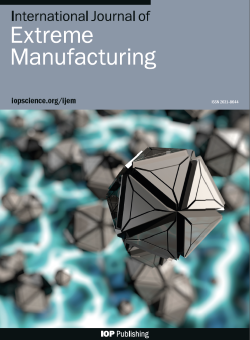
2020, 2(2) Column
International Journal of Extreme Manufacturing 第2卷 第2期
Due to the rapid development of precision manufacturing technology, much research has been conducted in the field of multisensor measurement and data fusion technology with a goal of enhancing monitoring capabilities in terms of measurement accuracy and information richness, thereby improving the efficiency and precision of manufacturing. In a multisensor system, each sensor independently measures certain parameters. Then, the system uses a relevant signalprocessing algorithm to combine all of the independent measurements into a comprehensive set of measurement results. The purpose of this paper is to describe multisensor measurement and data fusion technology and its applications in precision monitoring systems. The architecture of multisensor measurement systems is reviewed, and some implementations in manufacturing systems are presented. In addition to the multisensor measurement system, related data fusion methods and algorithms are summarized. Further perspectives on multisensor monitoring and data fusion technology are included at the end of this paper.
multi-sensor data fusion process monitoring additive manufacturing laser melting In the past decades, Moore’s law drives the semiconductor industry to continuously shrink the critical size of transistors down to 7 nm. As transistors further downscaling to smaller sizes, the law reaches its limitation, and the increase of transistors density on the chip decelerates. Up to now, extreme ultraviolet lithography has been used in some key steps, and it is facing alignment precision and high costs for high-volume manufacturing. Meanwhile, the introduction of new materials and 3D complex structures brings serious challenges for top-down methods. Thus, bottom-up schemes are believed to be necessary methods combined with the top-down processes. In this article, atomic level deposition methods are reviewed and categorized to extend Moore’s law and beyond. Firstly, the deposition brings lateral angstrom resolution to the vertical direction as well as top-down etching, such as double patterning, transfer of nanowires, deposition of nanotubes, and so on. Secondly, various template-assisted selective deposition methods including dielectric templates, inhibitors and correction steps have been utilized for the alignment of 3D complex structures. Higher resolution can be achieved by inherently selective deposition, and the underlying selective mechanism is discussed. Finally, the requirements for higher precision and efficiency manufacturing are also discussed, including the equipment, integration processes, scale-up issues, etc. The article reviews low dimensional manufacturing and integration of 3D complex structures for the extension of Moore’s law in semiconductor fields, and emerging fields including but not limited to energy, catalysis, sensor and biomedicals.
Moore’s law atomic level deposition high resolution selective deposition alignment Precision measurement tools are compulsory to reduce measurement errors or machining errors in the processes of calibration and manufacturing. The laser interferometer is one of the most important measurement tools invented in the 20th century. Today, it is commonly used in ultraprecision machining and manufacturing, ultraprecision positioning control, and many noncontact optical sensing technologies. So far, the state-of-the-art laser interferometers are the ground-based gravitational-wave detectors, e.g. the Laser Interferometer Gravitational-wave Observatory (LIGO). The LIGO has reached the measurement quantum limit, and some quantum technologies with squeezed light are currently being tested in order to further decompress the noise level. In this paper, we focus on the laser interferometry developed for space-based gravitational-wave detection. The basic working principle and the current status of the key technologies of intersatellite laser interferometry are introduced and discussed in detail. The launch and operation of these large-scale, gravitational-wave detectors based on space-based laser interferometry is proposed for the 2030s.
laser interferometry gravitational-wave detection inter-satellite laser ranging transponder laser interferometer Projection micro stereolithography (PμSL) is a high-resolution (up to 0.6 μm) 3D printing technology based on area projection triggered photopolymerization, and capable of fabricating complex 3D architectures covering multiple scales and with multiple materials. This paper reviews the recent development of the PμSL based 3D printing technologies, together with the related applications. It introduces the working principle, the commercialized products, and the recent multiscale, multimaterial printing capability of PμSL as well as some functional photopolymers that are suitable to PμSL. This review paper also summarizes a few typical applications of PμSL including mechanical metamaterials, optical components, 4D printing, bioinspired materials and biomedical applications, and offers perspectives on the directions of the further development of PμSL based 3D printing technology.
projection microstereolithography multiscale 3D printing multimaterial 3D printing Three types of scanning strategies, including the chessboard scanning strategy, the zigzag scanning strategy and the remelting scanning strategy, were conducted to study the effects of scanning strategies on surface morphology, microstructure, mechanical properties and the grain orientation of selective laser melted pure tungsten. The results showed that the pores and cracks were main defects in SLM-processed tungsten parts. The pores could be eliminated using the remelting scanning strategy. However, the cracks seemed to be inevitable regardless of the applied scanning strategies. The microstructures of SLM-processed tungsten were columnar grains and showed strong epitaxial growth along the building direction. A compressive strength of 923 MPa with an elongation of 7.7% was obtained when the zigzag scanning strategy was applied, which was the highest among the three scanning strategies. By changing the scanning strategies, the texture of SLM-processed tungsten in the direction of processing could be changed.
scanning strategy selective laser melting pure tungsten microstructure compressive strength texture 

